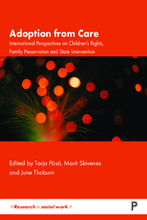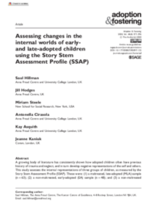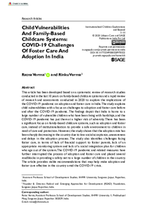Displaying 81 - 90 of 653
The current study used a randomized controlled trial to assess whether Attachment and Biobehavioral Catch-Up (ABC) improved the diurnal functioning of the hypothalamic–pituitary–adrenal (HPA) axis among 85 children who had been adopted internationally when they were between the ages of 4 and 33 months
This book introduces general topics on human rights and attachment, as well as a country-specific in-depth analysis of the legal and policy imperatives guiding adoptions from care, with a particular interest on the rights of children and their care-taking adults, including their birth parents
This study sought to validate the Early TRAuma-related Disorders Questionnaire (ETRADQ), a caregiver report which was developed to assess attachment disorders in school-age children based on the Diagnostic and Statistical Manual of Mental Disorders–Fifth edition criteria.
In this article, the authors describe young people’s emotional responses to birth family, and highlight implications for theory, research, and practice.
The Critical On-going Resource Family Education (CORE) Teen is a comprehensive foster parent training program designed to provide resource parents with the knowledge and skills to support teens in their care. This study examined results from trainings conducted across four states and one tribal nation in the U.S.
This study assesses the internal representations of three groups of children, as measured by the Story Stem Assessment Profile (SSAP). These were: (1) a maltreated, late-adopted (MLA); (2) a non-maltreated, early-adopted (EA) sample; and (3) a non-maltreated community sample (COMM).
This Chapter elucidates the objectives, scope, and challenges in the implementation of the 1993 Intercountry Adoption Convention.
This study examined the recurrent maltreatment of American Indian children in foster and adoptive homes, specifically the physical, emotional, sexual, and spiritual abuse subtypes, as well as poly-victimization of American Indian children in comparison to their White peers.
This article has been developed based on a systematic review of research studies conducted in the last 10 years on family-based childcare systems and a rapid review of research and assessments conducted in 2020 to explore the implications of the COVID-19 pandemic on adoption and foster care in India.
This study explored data obtained from surveys of caregivers who had previously adopted or assumed guardianship of a child from foster care in two U.S. states. Descriptive analyses summarized the demographic and wellbeing characteristics of children and families, and multivariate regression models estimated the association between these variables and caregiver commitment.




